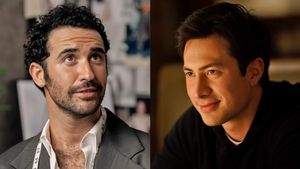While many questions remain unanswered in the death of Essay Anne Vanderbilt, the inventor of a revolutionary golf putter, it seems the world may yet fill in some of these blanks as a result of ongoing reporting. But what comes to light may not bode well for the editorial team of ESPN-affiliated sports website Grantland, whose recent report introduced the trans scientist to the world months after her suicide.
Last week Megan Finnerty at The Arizona Republic spoke with Gerri Jordan, Vanderbilt's former girlfriend and business partner. Finnerty's interview with Jordan provided some insight into Vanderbilt's emotional state during her final months.
Finnerty's powerful piece is emotional and heart-wrenching. "When I found her ... I thought, 'Why now? Why now are you doing this?'" Jordan told Finnerty of the moment last October when she found Vanderbilt lifeless on the bedroom floor in her Phoenix-area apartment.
When asked whether she believed Vanderbilt committed suicide as a result of Hannan's reporting, Jordan tearfully answered Finnerty's question. "I don't hold any grudge, really, since she's tried it before," Jordan explained. "So how can I say it's all his fault, when it's not really all his fault."
While Jordan acknowledged that Hannan's ethically questionable tactics weren't the direct cause of Vanderbilt's death, she said Hannan's actions did play a role in when Vanderbilt's life would come to a close. His reporting accounted for "90 percent" of the timing, Jorndan told Finnerty.
News of Vanderbilt's death has sparked numerous columns -- including one from this author -- with perhaps the most highly anticipated response coming from Grantland editor in chief Bill Simmons.
"[Hannan] never, at any time, threatened to out her on Grantland," Simmons wrote January 20 in his only public statement on the matter. Some interpreted this an an attempt to debunk the theory that Vanderbilt's suicide was directly linked to Hannan's reporting. "There was no hounding. There was no badgering. It just didn't happen that way."
Finnerty's interview with Jordan appears to contradict Simmons's statment.
"In early June, Vanderbilt was so nervous about being outed that she called at least one close friend -- [Gary] McCord, the CBS announcer -- so he wouldn't be surprised," reads Finnerty's article.
If Hannan never threatened to out her, why did Vanderbilt feel as though that's exactly what he planned to do?
Simmons's apology also twice refers to Vanderbilt as a "public figure." Public figures, as defined in a legal sense on Law.com, are "persons of great public interest or familiarity like a government official, politician, celebrity, business leader, movie star, or sports hero."
But Hannan's own reporting revealed that Vanderbilt actually did everything in her power to avoid becoming a public figure. There don't appear to be any social media accounts associated with her name, she avoided appearing in promotional videos for her putter, and on the website of the funeral home that carried out her cremation, there's a blank space in the "Life Story" section.
Vanderbilt didn't gain any notoriety until after her death, and she was not a public figure during her lifetime -- certainly not to the extent that most journalistic outlets would consider a person eligible to the heightened personal scrutiny that accompanies self-sought prominence.
After learning of Vanderbilt's death, Hannan concluded his lengthy piece by positioning itself as a eulogy to the inventor's life. The way this is framed has led some people to assume that Vanderbilt was completely alone in life, with exception of Jordan.
Finnerty, however, provides a much more human element to this story's conclusion:
After her death, Vanderbilt's three children came from Pennsylvania to sort through her belongings, and to pick up her ashes. Her daughter had remained in touch with Vanderbilt, but her sons had not.
[Deborah] Storey, a medical assistant and longtime friend, was with Jordan and the children at the funeral home and remembers it this way:
"When the boys walked in, they said, 'We're here to see our mother.' And they cried, two big, burly adult men."
"But they never really accepted her, never learned about the condition, never educated themselves about it. But when she died, they asked for their mother. It took her death for them to get it."
On Hannan's piece itself, ESPN ombudsman Robert Lipsyte admits that, controversy aside, the writing was not of particularly high quality. "Just a few moments into reading [Hannan's piece], it was shaping up as another one of those bloated selfies that clog the arteries of sports-lit these days," Lipsyte writes. "Four graphs and I was gone."
"The story itself is structurally clumsy and flabbily edited," continued Lipsyte, later going on to praise Finnerty for doing the reporting that Hannan did not. Lipsyte calls Finnerty's work "deep, empathetic reporting that Grantland might have achieved had it really stayed with the story to its core."




































































Charlie Kirk DID say stoning gay people was the 'perfect law' — and these other heinous quotes